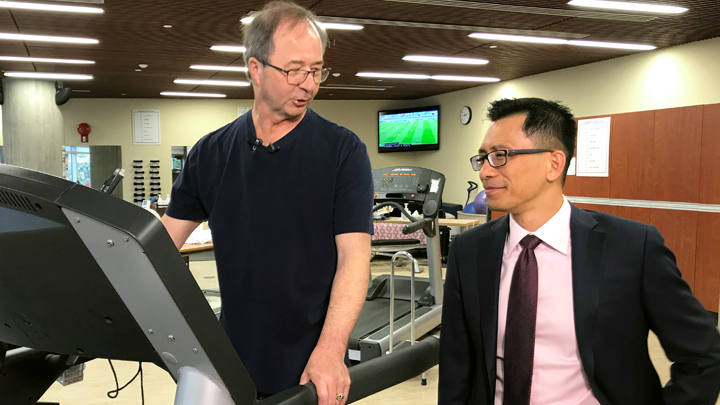
June 27, 2017

Keith Hutchings can now exercise without chest pain after two minimally-invasive procedures to bypass his blocked arteries were performed on him by interventional cardiologist Dr. Minh Vo at the Mazankowski Alberta Heart Institute.
Story and photo by Sharman Hnatiuk
Barely a week after cardiologists at the Mazankowski Alberta Heart Institute bypassed his blocked heart artery, Keith Hutchings was back at work.
Previously, an angiogram revealed that the 59-year-old was living with two completely blocked arteries and one that was 90-per-cent blocked.
“At first I thought I was going to need open-heart bypass surgery,” says Hutchings. “But then I was given the option of two less-invasive procedures, three months apart. I didn’t even have to stay overnight following the second procedure in April. I’m feeling great.”
Traditional coronary angioplasty — using a balloon or stent to widen the artery — can be used when an artery is partially blocked, but is ineffective when an artery is mostly or fully blocked.
The minimally-invasive technique is a new option at the Maz for patients with chronic total occlusion (complete blockage of a coronary artery) caused by a buildup of plaque.
Dr. Minh Vo, a newly recruited interventional cardiologist at the Maz, has been performing a procedure called antegrade dissection re-entry since his arrival last September.
Using a catheter inserted through the thigh or wrist, Dr. Vo inserts a mesh tube called a stent along the exterior artery wall on both sides of a blockage, restoring blood flow. The artery heals and accepts the new channel for blood flow.
In January, Dr. Vo became the first in the world to perform these advanced techniques using the TrapLiner — a specialized miniature device that enables the most complicated interventional procedures to be done more efficiently.
Approved by Health Canada, the TrapLiner arranges surgical tools in concentric circles inside a catheter. It allows the cardiologist to create a smaller hole in the artery, which is beneficial for frail, elderly patients who undergo antegrade dissection re-entry.
“This novel equipment allows for a safe and successful procedure in a much smaller hole providing more patient comfort,” says Dr. Vo. “This is a game-changer for patients with complete blockages of the coronary artery.”
Dr. Vo also credits AHS and the Cardiac Sciences team at the Maz for their support in establishing an internationally recognized program to treat these complex blockages.
More than 50 patients have undergone the procedure — avoiding open heart surgery — over the past eight months. Patients typically experience less pain, have reduced likelihood of complications and recover more quickly than those who undergo the more-invasive open-heart surgery.
“I’ve got three young grandchildren I want to be able to keep up with,” says Hutchings. “I’m so grateful this equipment and the expertise were available in Edmonton.”